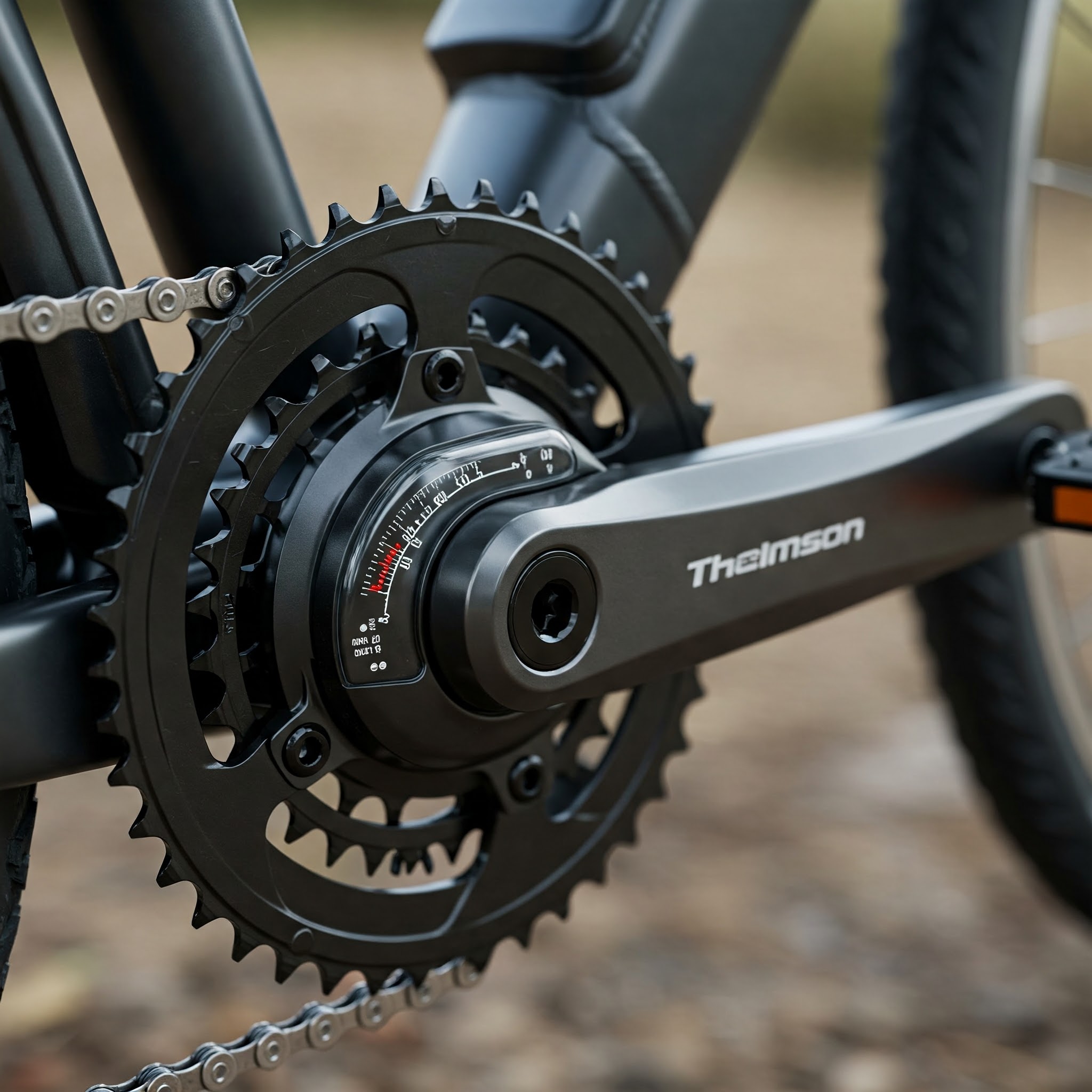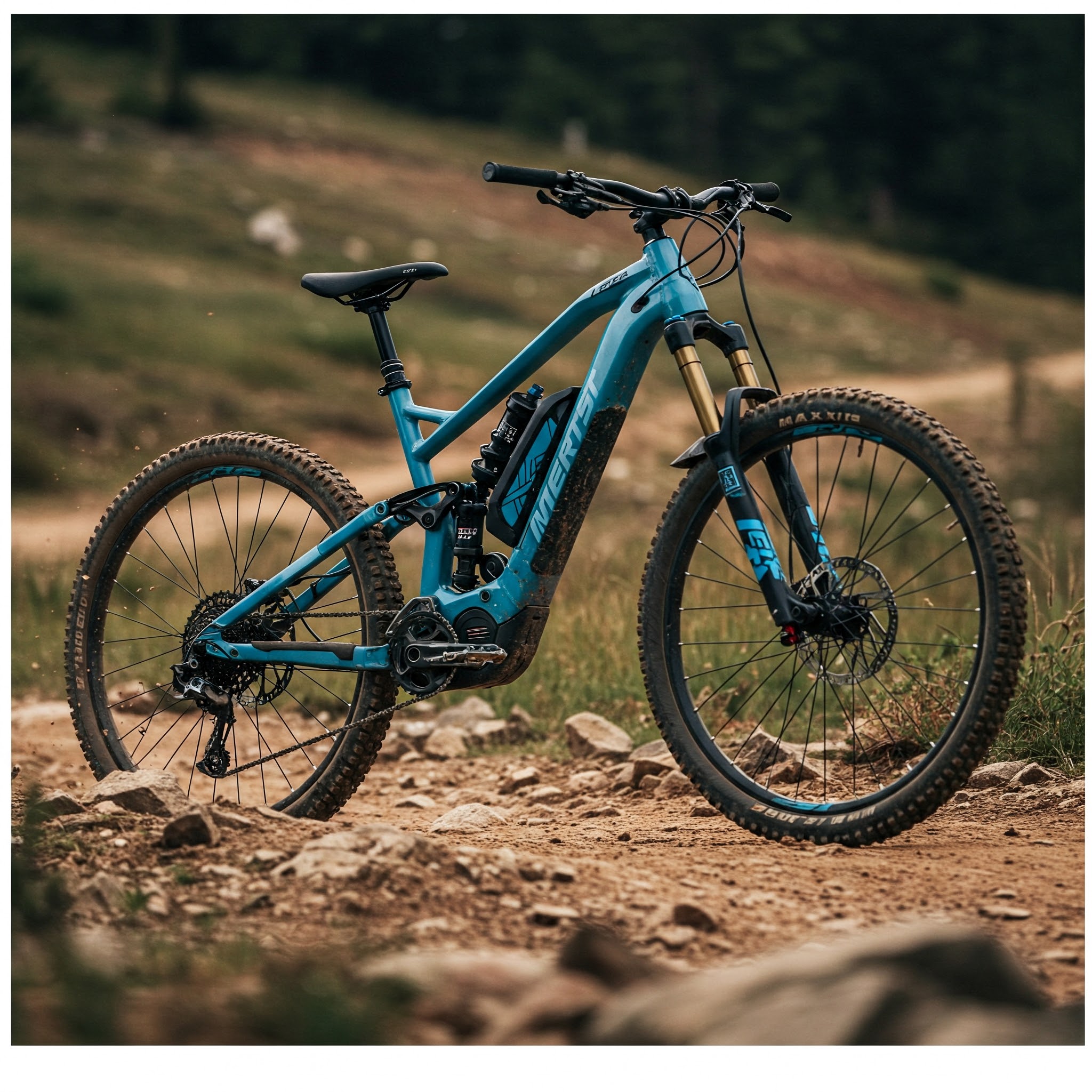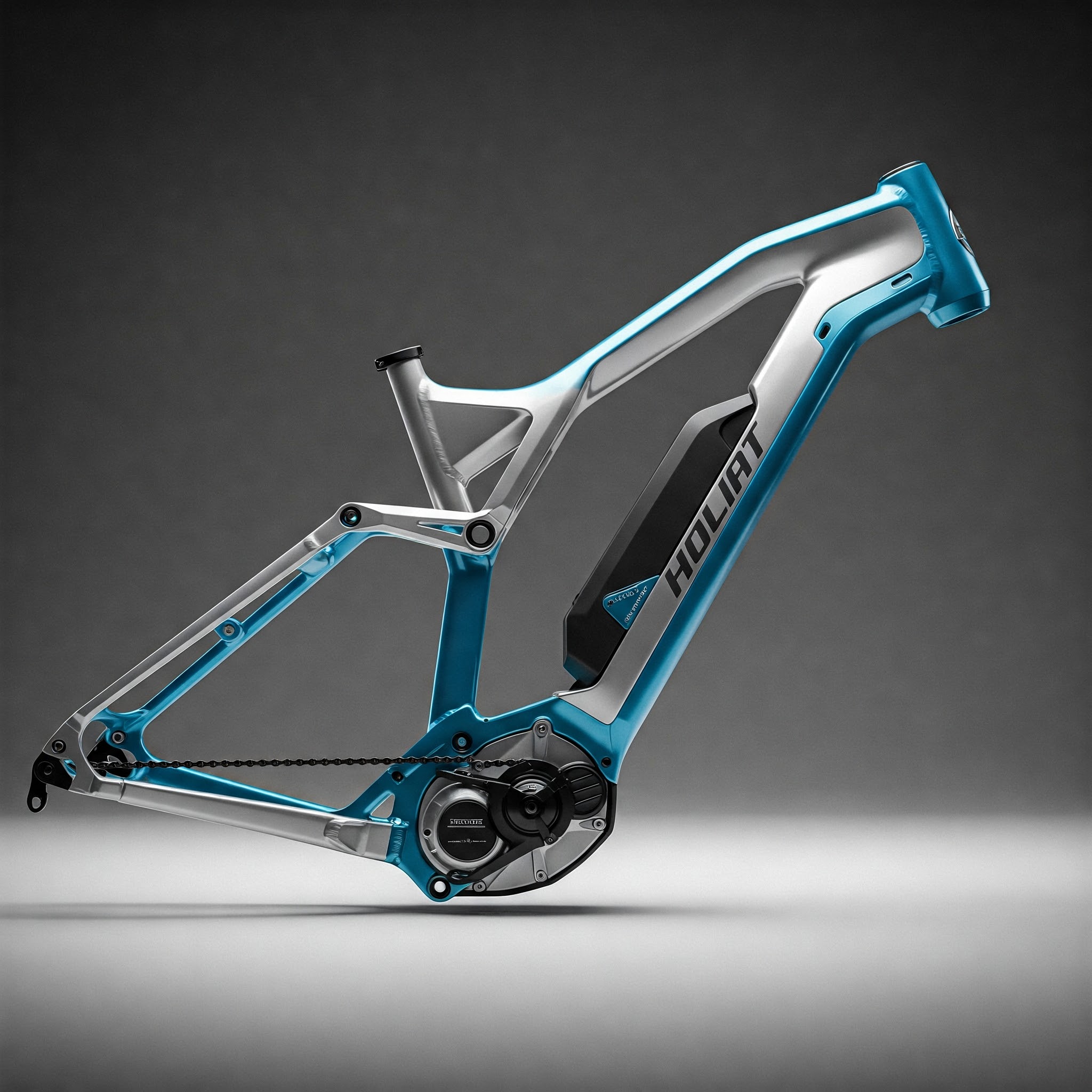The cycling world has witnessed a revolutionary transformation with the integration of advanced technology in recent years. At the forefront of this innovation stands the torque sensor ebike, a game-changing development that has redefined the riding experience for cyclists of all levels. Unlike traditional bicycles or even basic electric bikes, torque sensor ebikes offer an intuitive, responsive riding experience that feels like a natural extension of your own pedaling power.
✨Was this helpful? Spread the word! 🚀
As we navigate through 2025, the demand for torque sensor ebike models continues to surge, with more riders discovering the remarkable difference this technology makes. Whether you’re a daily commuter seeking efficiency, a weekend adventurer looking for extended range, or a fitness enthusiast wanting a customizable workout, understanding the nuances of torque sensor ebikes can significantly impact your riding experience.
In this comprehensive guide, we’ll delve into everything you need to know about torque sensor ebikes – from the fundamental technology that powers them to the top models available on the market today. We’ll explore how these sophisticated systems work, compare them with alternative sensors, and provide expert insights to help you make an informed decision when purchasing your next electric bike.
Understanding Torque Sensors vs. Other Ebike Sensors
Before diving deeper into the specifics of torque sensor ebikes, let’s compare this technology with other common sensor types found in electric bikes:
| Feature | Torque Sensor Ebike | Cadence Sensor Ebike | Speed Sensor Ebike | No Sensor (Throttle Only) |
|---|---|---|---|---|
| Riding Experience | Natural, intuitive assistance | On/off feel, less natural | Speed-dependent assistance | Manual control, no pedal assistance |
| Responsiveness | Immediate response to pedal pressure | Delayed response (½-1 rotation) | Moderate response time | Instant but requires throttle input |
| Battery Efficiency | High efficiency (15-30% more range) | Lower efficiency | Moderate efficiency | Low efficiency |
| Hill Climbing | Excellent, provides more power when needed | Less intuitive on varied terrain | Moderate performance | Entirely dependent on throttle control |
| Cost | Higher ($100-300 more) | Most affordable | Mid-range cost | Lowest production cost |
| Pedaling Feel | Smooth, like riding a regular bike with superpowers | Can feel mechanical/artificial | Somewhat natural | No pedal assistance |
| Ideal For | All-around cycling, fitness, technical terrain | Casual riders, budget-conscious buyers | Urban commuters | Those with limited mobility |
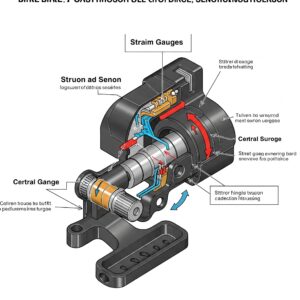
As the table illustrates, torque sensor ebikes provide a premium riding experience with natural assistance that responds precisely to your pedaling effort. While they typically come at a higher price point, the benefits in terms of ride quality, battery efficiency, and overall performance make them the preferred choice for discerning cyclists.
What Is a Torque Sensor Ebike?
A torque sensor ebike represents the pinnacle of electric bike technology, integrating sophisticated measurement systems that detect the exact force you apply to the pedals. Unlike simpler systems that merely register whether you’re pedaling or not, torque sensors measure the specific pressure you exert, allowing the motor to provide proportional assistance.
The Science Behind Torque Sensing Technology
At its core, a torque sensor ebike operates on a fundamental principle: the harder you pedal, the more assistance you receive. This creates a riding experience that feels incredibly natural and intuitive, almost as if the bike is reading your mind.
The torque sensor itself is typically located in one of three places:
- Bottom Bracket: The most common location, measuring the torque applied through the crankset
- Rear Hub: Found in some designs, measuring chain tension
- Pedal Axle: Less common but highly accurate, measuring force directly at the pedal
These sophisticated sensors use various technologies to measure torque:
- Strain Gauges: Detect microscopic deformations in metal components when force is applied
- Optical Sensors: Measure the twist of a specially designed shaft
- Magnetic Field Sensors: Detect changes in magnetic fields that correspond to applied force
The data from these sensors is processed by the bike’s controller, which then signals the motor to provide a proportionate level of assistance. This happens in milliseconds, creating a seamless connection between rider input and motor output that defines the premium torque sensor ebike experience.
How Torque Sensor Ebikes Feel Different
The difference between riding a torque sensor ebike and other electric bikes is immediately noticeable from the first pedal stroke. When you push harder on a torque sensor ebike, you get more assistance – creating a feeling often described as having “bionic legs” rather than being pushed by a motor.
✅ Seamless power delivery that matches your effort
✅ Natural acceleration without the jarring on/off feeling of simpler systems
✅ Precise control on technical terrain where modulation is critical
✅ Better workout potential as the system rewards your input
✅ Improved battery efficiency since power is only used when needed
As one torque sensor ebike enthusiast described it: “It doesn’t feel like the bike is doing the work for you; it feels like you’ve suddenly become an Olympic-level cyclist.”
Benefits of Torque Sensor Ebikes
The advantages of choosing a torque sensor ebike extend far beyond the intuitive riding experience. Let’s explore the comprehensive benefits that make these sophisticated machines worth the investment:
Enhanced Riding Experience
The primary appeal of torque sensor ebikes lies in how they transform the riding experience:
- Natural Feel: The bike responds to your effort in real-time, creating an extension of your own power rather than an external force.
- Smooth Transitions: Power delivery ramps up and down gradually as you change your pedaling force, eliminating the jerky on/off experience of basic systems.
- Better Control: Precisely modulate your speed on technical descents or busy urban streets by adjusting your pedaling pressure.
- Customizable Assistance: Many torque sensor ebike models allow you to adjust the relationship between your input and the motor’s response, letting you personalize your riding experience.
Superior Battery Efficiency
Your torque sensor ebike will typically deliver significantly better range than comparable models with simpler sensor systems:
| Sensor Type | Average Range (Same Battery) | Battery Efficiency | Power Usage Pattern |
|---|---|---|---|
| Torque Sensor | 40-70 miles | High | Proportional to effort, minimal waste |
| Cadence Sensor | 30-50 miles | Low-Medium | Often provides unnecessary power |
| Throttle Only | 20-40 miles | Low | Maximum power used regardless of need |
| Hybrid Systems | 35-60 miles | Medium | Varies based on system design |
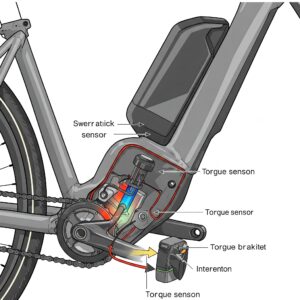
Studies have shown that torque sensor ebikes can deliver up to 30% more range from the same battery capacity compared to cadence-only systems, representing a significant advantage for riders who prioritize extended adventures or have range anxiety.
Improved Fitness Benefits
For those using ebikes as part of their fitness routine, torque sensor technology offers distinct advantages:
✅ Workout Customization: Adjust assistance levels to match your fitness goals
✅ Effort-Based Rewards: The more work you put in, the more help you receive
✅ Heart Rate Control: Maintain consistent effort by modulating your pedaling force
✅ Progressive Training: Gradually decrease assistance as fitness improves
✅ Rehabilitation Support: Provides perfect assistance for those recovering from injury
A recent study published in the Journal of Transport & Health found that ebike riders with torque sensors were more likely to engage in longer rides and achieved better cardiovascular benefits than those using simpler systems, largely due to the more engaging and natural riding experience.
Technical Terrain Performance
For off-road enthusiasts, the advantages of torque sensor ebikes become even more pronounced:
- Precise Power Modulation: Navigate technical climbs with exactly the right amount of assistance.
- Traction Management: Adjust your input to maintain grip on loose surfaces without overwhelming the tire’s contact patch.
- Battery Conservation: Get more range on long trail rides by using power efficiently.
- Natural Trail Experience: Preserve the essence of mountain biking while getting assistance when needed.
As trail access debates continue in many regions, the natural riding characteristics of torque sensor ebikes have helped them gain acceptance in some areas where other ebikes remain controversial, according to the International Mountain Bicycling Association.
How Torque Sensor Ebike Systems Work
To truly appreciate the sophistication of a torque sensor ebike, it’s worth understanding the intricate mechanics and electronics that create this seamless riding experience.
The Technical Components
A complete torque sensor system in an ebike consists of several critical components working in harmony:
- Torque Measurement Device: The actual sensor that detects the force applied to the pedals.
- Rotational Speed Sensor: Measures pedaling cadence to factor into the assistance equation.
- Motor Controller: The electronic brain that processes sensor data and determines motor output.
- User Interface: Displays and controls that allow rider interaction with the system.
- Motor: The electric drive unit that delivers the proportional assistance.
Each component must be precisely calibrated to work together, which explains why torque sensor ebikes typically command a premium price point compared to simpler electric bikes.
Signal Processing and Response Time
What truly separates high-quality torque sensor ebikes from lesser alternatives is the sophistication of signal processing and system response:
| Aspect | High-End Torque Sensor Ebike | Basic Torque Sensor Ebike | Cadence Sensor Ebike |
|---|---|---|---|
| Response Time | 10-50 milliseconds | 50-200 milliseconds | 250-1000 milliseconds |
| Sensing Resolution | 256+ levels of torque detection | 32-128 levels of detection | Binary (on/off) |
| Processing Algorithm | Complex mapping with multiple variables | Simple multiplication factor | Basic threshold detection |
| Calibration Precision | Factory calibrated to 1-2% accuracy | Basic calibration | Not applicable |
| Adaptive Learning | May adjust to rider patterns over time | Static programming | Static programming |
✨ Don’t Miss These Exclusive Deals! 🚴♂️
➡ Ready to experience the responsive, natural feel of a torque sensor ebike? Click on any of the highlighted models to check current pricing and availability. The perfect combination of human power and electric assistance is just a click away – transform your riding experience today!
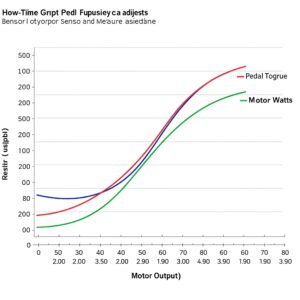
On premium torque sensor ebike models, engineers have implemented sophisticated algorithms that account for:
- Initial pedal force spikes when starting from a stop
- Cadence variations and their relationship to desired assistance
- Terrain changes detected through inclinometers or GPS data
- Rider-selected power modes and preferences
- Battery state of charge and temperature conditions
This complex processing happens instantaneously, delivering an experience where the line between rider and machine begins to blur – the hallmark of a truly exceptional torque sensor ebike.
Torque Sensor Types and Placement
Different manufacturers have developed various approaches to torque sensing technology, each with distinct characteristics:
Bottom Bracket Torque Sensors
The most common design, these sensors are integrated into the bottom bracket where the cranks connect to the frame. They typically use strain gauges to measure the minute deformation of the spindle under pedaling force.
Advantages:
- Direct measurement of pedaling force
- Protected location within the frame
- Industry-standard integration
Examples: Bosch Performance Line CX, Shimano EP8, Brose Drive S
Rear Dropout Torque Sensors
Some systems measure chain tension at the rear dropout to calculate torque.
Advantages:
- Simplified integration with standard bottom brackets
- Can be added to conventional bike designs more easily
- Often less expensive to implement
Examples: Certain TDCM and Bafang systems
In-Pedal Sensors
The newest innovation places sensors directly in the pedals themselves.
Advantages:
- Most direct measurement of actual applied force
- Can distinguish between left and right pedal input
- Potential for advanced biomechanical analysis
Examples: Favero Assioma power meter pedals (adapted for ebike use)
Leading torque sensor ebike manufacturers often develop proprietary systems or partner with specialized component makers to create exclusive sensor packages that differentiate their products in the marketplace.
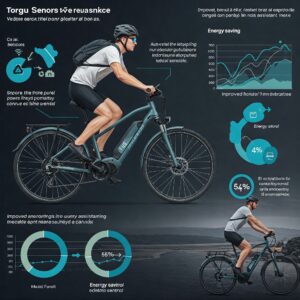
Top Torque Sensor Ebike Models for 2025
The market for torque sensor ebikes has expanded dramatically, with options now available across various price points and riding disciplines. Here are some of the standout models for 2025:
Premium Urban Commuters
For the daily rider seeking the ultimate commuting experience, these torque sensor ebike models offer exceptional quality and features:
- Specialized Turbo Vado SL 5.0 EQ combines a lightweight design (under 40 lbs) with the sophisticated SL 1.1 motor system featuring true torque sensing technology. The integrated Future Shock 1.5 suspension creates an incredibly smooth ride, while the 320Wh internal battery (expandable with range extender) provides up to 80 miles of range. Perfect for the discerning urban professional.
- Trek Allant+ 9.9S features the Bosch Performance Line Speed motor with precise torque sensing and an impressive 625Wh battery. Its premium carbon frame and SRAM electronic shifting create a commuting experience that rivals many cars for urban transport efficiency.
- Riese & Müller Charger4 GT touring showcases German engineering excellence with dual-battery capability (up to 1,250Wh), full suspension, and the Bosch Performance Line CX motor with torque sensor integration. The belt drive and internal gear hub eliminate maintenance concerns.
Mountain Torque Sensor Ebikes
Off-road enthusiasts seeking technical performance will appreciate these torque sensor ebike options:
- Santa Cruz Heckler MX CC X01 AXS RSV represents the pinnacle of electric mountain biking, featuring the Shimano EP801 motor system with sophisticated torque sensing that preserves the natural trail feel while providing 85Nm of torque. The mixed-wheel design (29″ front, 27.5″ rear) offers agile handling and the 720Wh battery ensures all-day adventures.
- Specialized Turbo Levo Expert Carbon combines the incredibly natural-feeling Specialized 2.2 motor (offering 90Nm of torque) with their advanced TCU display that provides 320% rider amplification. The MasterMind motor control unit continuously optimizes the torque curve based on riding conditions.
- YT Decoy Core 4 29/MX delivers exceptional value with the Shimano EP8 drive system featuring precise torque sensing capabilities. The progressive geometry and virtual four-link suspension design provide a ride quality that has garnered industry acclaim.
Value-Oriented Torque Sensor Ebikes
Quality torque sensor technology is becoming more accessible, as these more affordable options demonstrate:
- Ride1Up Prodigy XC stands out as an exceptional value, offering a Brose TF Sprinter mid-drive motor with true torque sensing capability at a fraction of the price of premium brands. Despite its reasonable $2,295 price tag, it delivers components typically found on bikes costing $1,000+ more.
- Aventon Level.2 Commuter combines an approachable price point with a torque sensor system that delivers smooth, natural assistance. The integrated lights, fenders, and rack make it a complete package for urban riders.
- REI Co-op CTY e2.2 proves that a quality torque sensor ebike experience doesn’t have to break the bank. The Shimano E5000 mid-drive motor delivers reliable, natural assistance backed by REI’s exceptional warranty and service.
Specialized Use Torque Sensor Ebikes
For riders with specific needs, these purpose-built torque sensor ebike models offer targeted solutions:
- Tern GSD S00 LX redefines utility with its compact cargo design capable of carrying up to 440 lbs including rider. The Bosch Cargo Line motor features sophisticated torque sensing calibrated specifically for heavy load starts and stops, while dual battery capability provides range even when fully loaded.
- Riese & Müller Load 75 takes the cargo concept even further with its front-loading design and Bosch Cargo Line motor featuring torque sensing optimized for heavy-duty use. The full suspension design maintains handling precision even with substantial cargo.
- Stromer ST5 ABS pushes the boundaries of high-speed commuting with its powerful rear-hub motor that incorporates proprietary torque sensing technology, allowing speeds up to 28mph with natural pedaling feel. The ABS braking system adds a safety layer for high-speed commuting.
Torque Sensor Ebike Component Comparison
For those building custom ebikes or upgrading existing systems, understanding the differences between available torque sensor drive systems is essential:
| Drive System | Torque Output | Battery Compatibility | Weight | Noise Level | Price Range | Standout Feature |
|---|---|---|---|---|---|---|
| Bosch Performance Line CX | 85Nm | Bosch PowerTube/Pack | 2.9kg | Low-Medium | $$$$ | eMTB mode with progressive assistance |
| Shimano EP8 | 85Nm | Shimano/Open | 2.6kg | Low | $$$$ | Customizable power curves via app |
| Brose Drive S Mag | 90Nm | Open standard | 2.9kg | Very Low | $$$$ | Virtually silent operation |
| Yamaha PW-X3 | 85Nm | Yamaha/Open | 2.75kg | Medium | $$$ | Quad sensor system includes angle detection |
| Fazua Ride 60 | 60Nm | Proprietary | 1.96kg | Low | $$$ | Lightest system with true torque sensing |
| TQ HPR 120S | 120Nm | TQ/Open | 3.9kg | Low | $$$$$ | Highest torque in smallest package |
| Bafang M600 | 120Nm | Open standard | 3.9kg | Medium-High | $$ | Budget-friendly with high torque |
💬 Just one click – help others make better buying decisions too!😊
✨ Don’t Miss These Exclusive Deals! 🚴♂️
➡ Ready to experience the responsive, natural feel of a torque sensor ebike? Click on any of the highlighted models to check current pricing and availability. The perfect combination of human power and electric assistance is just a click away – transform your riding experience today!
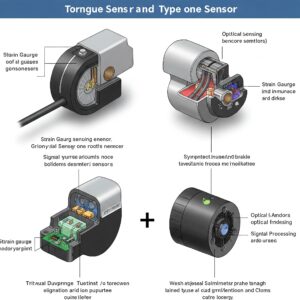
The torque sensor quality and implementation vary significantly between these systems, with premium options like Bosch, Shimano, and Brose offering more sophisticated torque mapping and natural feel compared to budget alternatives.
How to Choose the Right Torque Sensor Ebike
With so many options available, selecting the perfect torque sensor ebike requires careful consideration of several factors:
Assessing Your Riding Needs
Before exploring specific models, clarify your primary use case:
✅ Commuting: Focus on reliability, weather protection, integrated features
✅ Fitness: Consider weight, resistance levels, and workout data options
✅ Recreation: Evaluate comfort, range, and ease of use
✅ Off-Road: Prioritize suspension quality, component durability, and technical performance
✅ Utility: Assess cargo capacity, stability, and load-specific motor tuning
Your honest assessment of how you’ll actually use the bike—not how you imagine you might use it—will guide your selection process toward the most suitable torque sensor ebike for your lifestyle.
Key Features to Consider
When comparing torque sensor ebike models, pay particular attention to these critical factors:
- Sensor Quality and Implementation: Not all torque sensors are created equal. Research how each bike’s system handles start-up torque, variable cadence, and transition between assistance levels.
- Motor Characteristics: Consider peak torque (measured in Nm), but also how that torque is delivered across different conditions. Some systems excel at low-cadence climbing while others prioritize efficiency and range.
- Battery Capacity and Integration: Look beyond the raw Wh numbers to understand charging options, expected lifecycle, replacement costs, and whether removable or integrated designs better suit your situation.
- Component Quality: The non-electric aspects of the bike remain crucial—quality brakes, appropriate gearing, and durable contact points contribute significantly to the overall experience.
- Software and Connectivity: Modern torque sensor ebikes often feature companion apps that allow customization of assistance characteristics, tracking of rides, and diagnostic capabilities.
- After-Sale Support: The complexity of torque sensor ebike systems makes dealer support, warranty terms, and parts availability especially important considerations.
Making the Investment: Budget Considerations
Torque sensor ebikes represent a significant investment, but understanding the cost structure helps put prices in perspective:
| Price Range | What to Expect | Best For |
|---|---|---|
| $1,500-2,500 | Basic torque sensing, reliable components, limited features | Entry-level commuters, recreational riders |
| $2,500-4,000 | Refined torque sensing, quality components, good feature integration | Dedicated commuters, fitness enthusiasts |
| $4,000-6,000 | Premium torque sensing systems, high-end components, full feature set | Serious cyclists, daily commuters, enthusiasts |
| $6,000+ | Cutting-edge technology, top-tier components, specialized designs | Professional users, no-compromise consumers |

When evaluating torque sensor ebike prices, consider the total cost of ownership. A quality electric bike with torque sensing technology can replace car trips, reduce transportation costs, and provide health benefits that may justify the initial investment over time.
According to a study by Portland State University, ebike owners reported saving an average of $45 per week on transportation costs after purchasing their electric bikes, suggesting that even premium torque sensor ebikes can offer a reasonable payback period for frequent riders.
Maintaining Your Torque Sensor Ebike
The sophisticated technology in a torque sensor ebike requires proper maintenance to ensure optimal performance and longevity:
Regular Maintenance Schedule
Follow this maintenance timeline to keep your torque sensor ebike performing at its best:
Before Every Ride:
- Check tire pressure
- Verify battery charge
- Test brake function
- Ensure motor engages properly
Weekly:
- Clean frame and components
- Inspect for loose fasteners
- Check drive system for unusual noises
- Verify sensor calibration with a quick test ride
Monthly:
- Inspect chain/belt wear
- Check brake pad thickness
- Examine tires for wear or damage
- Test battery capacity against baseline
Quarterly:
- Complete drivetrain cleaning
- Update system firmware if available
- Check all electrical connections
- Inspect frame for any stress indicators
Annually:
- Professional service check of motor system
- Battery health diagnostic
- Complete bike overhaul including torque sensor calibration
- Safety inspection of all components
Torque Sensor Calibration and Care
The heart of your torque sensor ebike—the sensing system itself—deserves special attention:
- Avoid Impact: Protect the bottom bracket area from impacts that could affect sensor alignment.
- Follow Proper Startup Sequence: Many systems require a specific startup procedure to calibrate properly (like avoiding pressure on pedals during initialization).
- Periodic Recalibration: Some systems benefit from periodic dealer recalibration, especially after significant component changes.
- Software Updates: Keep the bike’s firmware updated to benefit from sensor algorithm improvements.
- Battery Maintenance: Follow manufacturer guidelines for battery care, as voltage irregularities can affect sensor performance.
- Professional Assessment: Have a qualified technician evaluate sensor performance annually, as subtle degradation might not be immediately apparent.
Most torque sensor ebike manufacturers have moved beyond the early reliability issues that plagued some first-generation systems. Modern sensors from reputable brands typically provide thousands of trouble-free riding hours when properly maintained.
✨ Elevate Your Riding Experience Today! 🚴♂️
➡ Ready to experience the remarkable difference a quality torque sensor ebike can make? The models highlighted above represent the best options available in 2025, each offering the intuitive, natural riding experience that only true torque sensing technology can deliver. Whether you’re commuting, exploring trails, or simply enjoying recreational rides, investing in a torque sensor ebike will transform your cycling experience with precise, responsive power delivery that feels like a natural extension of your own abilities. Click on any of the highlighted products to check current pricing and availability!
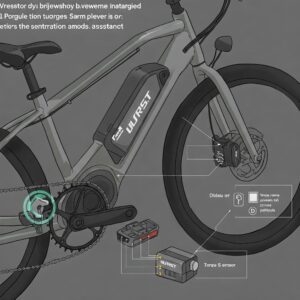
Conclusion
The torque sensor ebike represents the pinnacle of electric bicycle technology, offering a riding experience that harmoniously blends human power with electric assistance in a way that feels natural, intuitive, and engaging. As we’ve explored throughout this comprehensive guide, the sophisticated sensing technology at the heart of these bikes creates a riding experience that transcends what’s possible with simpler systems.
While the investment in a quality torque sensor ebike is certainly significant, the returns in terms of riding enjoyment, efficiency, and versatility make it worthwhile for those who value a premium cycling experience. From daily commuters to weekend adventurers, fitness enthusiasts to technical trail riders, torque sensor technology enhances the riding experience in ways that must be experienced to be fully appreciated.
As the technology continues to evolve and become more accessible, we can expect to see torque sensing become the standard across a broader range of electric bikes. For now, the models highlighted in this guide represent the best options available for riders seeking the ultimate ebike experience in 2025.
Whether you’re new to electric bikes or looking to upgrade from a basic system, the transition to a torque sensor ebike will transform your relationship with cycling, extending your range, enhancing your capabilities, and ultimately rekindling the pure joy of riding that drew many of us to bicycles in the first place.
Torque Sensor Ebike FAQs
❓ How much does a quality torque sensor ebike typically cost?
✅ Quality torque sensor ebikes range from $1,500-$8,000+ depending on components and features. Entry-level models with basic torque sensing start around $1,500-$2,500, while mid-range options fall between $2,500-$4,000. Premium models from manufacturers like Specialized, Trek, and Riese & Müller typically cost $4,000-$6,000, with high-end specialized designs exceeding $8,000...
❓ Are torque sensor ebikes worth the extra cost over cadence sensor models?
✅ Yes, torque sensor ebikes justify their higher price through superior riding experience, better battery efficiency, and more precise control. The natural feel of proportional assistance typically delivers 15-30% better range from the same battery capacity compared to cadence-only systems. For daily riders, the improved experience and efficiency generally outweigh the $300-$800 price premium over comparable cadence sensor models...
❓ What's the typical range of a torque sensor ebike?
✅ Torque sensor ebikes typically achieve 40-80 miles of range depending on battery size, terrain, rider weight, and assistance level. Models with 500Wh batteries generally provide 40-50 miles of range under mixed conditions, while those with 700Wh+ batteries can exceed 70 miles. The efficiency advantage of torque sensors means they typically deliver 15-30% more range than cadence sensor ebikes with equivalent battery capacity...
❓ Can I upgrade my existing ebike to add a torque sensor?
✅ Converting an existing ebike to use a torque sensor is technically possible but often impractical and expensive. The process typically requires replacing the entire drive system including motor, controller, display, and bottom bracket. Costs range from $800-$1,500 for components plus $200-$400 for professional installation. Most experts recommend purchasing a purpose-built torque sensor ebike rather than attempting conversion...
❓ Which ebike brands have the best torque sensor implementation?
✅ The brands consistently rated highest for torque sensor quality include Bosch, Shimano, Specialized, Brose, and Yamaha. Bosch's Performance Line CX and Shimano's EP8 systems offer exceptional responsiveness with 85Nm of torque. Specialized's proprietary SL 1.1 system provides the most natural-feeling assistance according to multiple expert reviews. For value-conscious shoppers, Fazua and Bafang offer good torque sensing capabilities at lower price points...
Recommended for You:
- 10 Best E Bike Brake Pads For Ultimate Stopping Power and Safety in 2025
- 10 Essential E Bike Suspension Systems For Ultimate Comfort in 2025
- 10 Essential Ebike Wheel Facts Every Smart Rider Should Know in 2025
Disclaimer: This article contains affiliate links. If you purchase products through these links, we may earn a small commission at no additional cost to you.
✨ Found this helpful? Share it with your friends! 💬🤗
